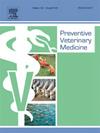Navigating the controversy: Public perspectives on free-roaming cat populations and control strategies in Israel
IF 2.2
2区 农林科学
Q1 VETERINARY SCIENCES
引用次数: 0
Abstract
The debate surrounding the management of free-roaming cat populations is multifaceted, with conflicting views between conservationists and cat advocates. In Israel, which is characterized by densely populated free-roaming cat communities, cat numbers remain high despite extensive Trap-Neuter-Return (TNR) efforts. Recognizing the importance of public engagement for ensuring success of control campaigns, we aimed to gather public opinion on the free-roaming cat phenomenon and control strategies. Interviews were conducted with 700 randomly selected passersby at central bus and train stations nationwide. A notable fraction (223, 31.9 %) of the participants reported feeding free-roaming cats at least once during the month preceding the survey. Two sub-groups of dedicated feeders were identified: eighty feeders (11.4 %) who reported feeding on a daily basis, and forty-one (5.9 %) ‘heavy’ feeders who reported feeding more than ten cats. While feeders and non-feeders of free-roaming cats shared similar characteristics, daily feeders were generally older, and fewer were Israeli-born. 54 % of all participants and 45 % of the dedicated feeders considered free-roaming cats as a negative phenomenon. However, feeders typically regarded feeding free-roaming cats as beneficial (75 % strongly agreed with feeding free-roaming cats), while non-feeders exhibited a more ambivalent attitude (30 % disagreed and 35 % strongly agreed with feeding actions). Remarkably, both feeders and non-feeders agreed that the numbers of free-roaming cats should be reduced (77.3 % of all participants). In addition, most participants (62 % of all participants) agreed at least partially with the application of neutering as a cat population management tool, while the vast majority (90 % of all participants) rejected the idea of culling. In conclusion, the general public perceives free-roaming cats negatively, and as a consequence, there is widespread support for the necessity to reduce cat numbers. However, the strong association between abundance of vital resources, such as food provided by feeders, and the cat population dynamics, is not understood or disregarded by both feeder and non-feeders of free-roaming cats. Authorities should therefore consider combining cat control programs with public education campaigns to raise public awareness of this issue.
引导争议:公众对以色列自由漫游的猫数量和控制策略的看法
围绕管理自由漫游的猫的争论是多方面的,在保护主义者和猫的倡导者之间有相互矛盾的观点。在以色列,人口密集的自由流浪猫社区的特点是,尽管采取了大量的“陷阱-绝育-返回”(TNR)措施,但猫的数量仍然很高。认识到公众参与对确保控制运动成功的重要性,我们旨在收集公众对自由漫游猫现象和控制策略的意见。采访对象是在全国各地的中央汽车站和火车站随机抽取的700名路人。相当一部分参与者(223,31.9 %)报告在调查前一个月至少喂过一次自由漫游的猫。确定了专门喂食者的两个亚组:80名喂食者(11.4% %)报告每天喂食,41名“重度”喂食者(5.9% %)报告喂食10只以上的猫。虽然自由漫游猫的喂食者和非喂食者有相似的特征,但每日喂食者通常年龄较大,以色列出生的人较少。54% %的参与者和45% %的专门喂食者认为自由漫游的猫是一种负面现象。然而,喂食者通常认为喂养自由漫游的猫是有益的(75% %强烈同意喂养自由漫游的猫),而非喂食者表现出更加矛盾的态度(30% %不同意,35% %强烈同意喂养行为)。值得注意的是,喂食者和非喂食者都同意应该减少自由漫游的猫的数量(77.3% %的参与者)。此外,大多数参与者(占所有参与者的62% %)至少部分同意将绝育作为猫种群管理工具的应用,而绝大多数参与者(占所有参与者的90% %)反对扑杀的想法。总之,公众对自由漫游的猫的看法是消极的,因此,人们普遍支持减少猫数量的必要性。然而,自由漫游猫的喂食者和非喂食者都没有理解或忽视重要资源(如喂食者提供的食物)的丰富性与猫种群动态之间的密切联系。因此,当局应考虑将猫控制项目与公共教育运动结合起来,以提高公众对这一问题的认识。
本文章由计算机程序翻译,如有差异,请以英文原文为准。
求助全文
约1分钟内获得全文
求助全文
来源期刊

Preventive veterinary medicine
农林科学-兽医学
CiteScore
5.60
自引率
7.70%
发文量
184
审稿时长
3 months
期刊介绍:
Preventive Veterinary Medicine is one of the leading international resources for scientific reports on animal health programs and preventive veterinary medicine. The journal follows the guidelines for standardizing and strengthening the reporting of biomedical research which are available from the CONSORT, MOOSE, PRISMA, REFLECT, STARD, and STROBE statements. The journal focuses on:
Epidemiology of health events relevant to domestic and wild animals;
Economic impacts of epidemic and endemic animal and zoonotic diseases;
Latest methods and approaches in veterinary epidemiology;
Disease and infection control or eradication measures;
The "One Health" concept and the relationships between veterinary medicine, human health, animal-production systems, and the environment;
Development of new techniques in surveillance systems and diagnosis;
Evaluation and control of diseases in animal populations.
 求助内容:
求助内容: 应助结果提醒方式:
应助结果提醒方式:


